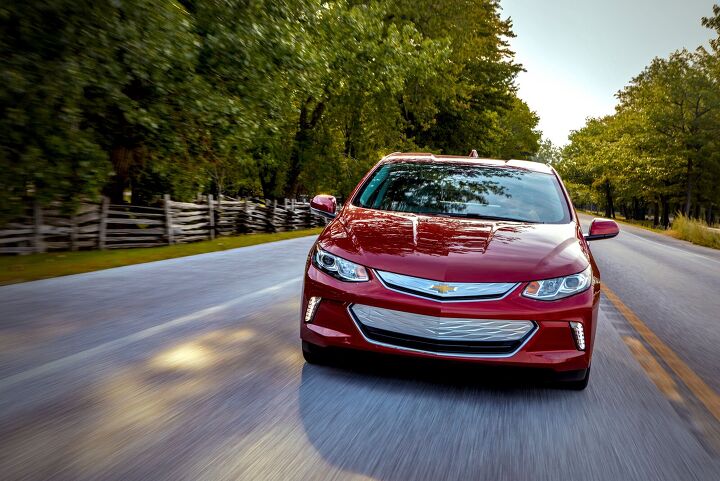General Motors Bringing Back Plug-in Hybrids

Despite previously having committed itself toward a future where it builds all-electric vehicles, General Motors has made plans to bring plug-in hybrids back to our market. That’s according to CEO Mary Barra, who announced on Tuesday that the automaker would be leaning on hybrid vehicles to help contend with increasingly strict emission regulations.
"Our forward plans include bringing our plug-in hybrid technology to select vehicles in North America," Barra was quoted by Automotive News as saying during GM’s fourth-quarter earnings call. "Let me be clear: GM remains committed to eliminating tailpipe emissions from our light-duty vehicles by 2035. But in the interim, deploying plug-in technology in strategic segments will deliver some of the environmental benefits of EVs as the nation continues to build its charging infrastructure."
While we can only speculate as to her rationale, it seems plausible that lackluster EV demand is causing the company to think twice about its pre-existing plans. While most automakers have made sweeping promises about electrification, GM’s commitment appears stronger than most. The brand has expressed plans to electrify its entire future lineup using the Ultium platform and was arguably pushing forward with controversial "mobility" trends (e.g. OnStar, GM Marketplace, etc) while core rivals were just starting to get serious.
Unfortunately, being early to the party doesn’t appear to have left the automaker with a clear advantage. Like most legacy manufacturers trying their hand at all-electric vehicles, GM has failed to make them profitable and doesn’t expect to make any money from that side of the business until 2025. The assumption being that profits will come once the company has built more high-margin examples and battery production reaches a point where costs begin to come down.
Simply chasing volume probably won’t be enough. General Motors already delivered the Chevrolet Bolt, with the model becoming one of the first affordable EVs offering real utility to customers. But it wasn’t making oodles of cash per vehicle like the company’s larger pickups and SUVs had been. Like most American automakers, General Motors dumped smaller vehicles in an era where people are having fewer children just to chase profits in the 2010s. The logic was that the larger vehicles boasted superior margins and should be prioritized.
Now it’s trying to extend that reasoning to EVs, despite the luxury market for electric vehicles already being heavily saturated and there being strong evidence that average Americans are being priced out of the new-car market entirely. Dealers have likewise expressed the need for more hybrids and fewer battery electric models based on consumer research efforts.
Hybrids could be a solution, especially as government dictum has effectively been forcing the industry into building compliance models. Plenty of automakers offer competent, hybridized versions of their most-popular products as a way to help contend with emission regulations. But this hasn’t been GM’s style in the past.
Hybrid versions of Chevy sedans and crossovers were short lived and most of the hybrid vehicles the company is well known for were abject flops. The Cadillac ELR was too weird and came via a marketing campaign that rubbed everyone the wrong way. It was a similar situation for the Chevy Volt, leaving the brand to lean on a cluster of normal-looking hybrids that were promptly forgotten. Unless I’m mistaken, the only hybrid it currently offers is the performance focused Corvette E-Ray.
As of now, General Motors’ official plans don’t appear to have changed. Buick and Cadillac are still supposed to pioneer the automaker’s electrification efforts (even though the company’s flagship EVs presently sail under the GMC or Chevrolet marquee) and will eventually host nothing but electric models by 2030. The manufacturer is likewise building new facilities to help boost EV production volumes both domestically and abroad.
However, Buick sales figures have clearly been trending in the wrong direction since roughly 2015. Cadillac has fared better, even though it’s also been losing its market share. But both have seen dealerships culled as part of new factory requirements designed to encourage retailers to update facilities in a way that the factory claims better prepares them to sell the promised onslaught of electrified products. Roughly half of all Buick dealerships allowed themselves to be bought out in 2023, mimicking what we saw when Johan De Nysschen (former Cadillac boss) decided there were too many Caddy dealerships in 2015.
Expect General Motors to clarify Barra’s statements on hybrid vehicles in the coming months. As of now, the company has not confirmed which models would become PHEVs. But it seems logical that efforts would focus around higher volume models as the company reconsiders the lineup.
[Image: General Motors]
Become a TTAC insider. Get the latest news, features, TTAC takes, and everything else that gets to the truth about cars first by subscribing to our newsletter.

A staunch consumer advocate tracking industry trends and regulation. Before joining TTAC, Matt spent a decade working for marketing and research firms based in NYC. Clients included several of the world’s largest automakers, global tire brands, and aftermarket part suppliers. Dissatisfied with the corporate world and resentful of having to wear suits everyday, he pivoted to writing about cars. Since then, that man has become an ardent supporter of the right-to-repair movement, been interviewed on the auto industry by national radio broadcasts, driven more rental cars than anyone ever should, participated in amateur rallying events, and received the requisite minimum training as sanctioned by the SCCA. Handy with a wrench, Matt grew up surrounded by Detroit auto workers and managed to get a pizza delivery job before he was legally eligible. He later found himself driving box trucks through Manhattan, guaranteeing future sympathy for actual truckers. He continues to conduct research pertaining to the automotive sector as an independent contractor and has since moved back to his native Michigan, closer to where the cars are born. A contrarian, Matt claims to prefer understeer — stating that front and all-wheel drive vehicles cater best to his driving style.
More by Matt Posky
Latest Car Reviews
Read moreLatest Product Reviews
Read moreRecent Comments
- Offbeat Oddity I would have to test them out, but the Corolla might actually have a slight edge. I'd prefer the 2.0 in both cars, but to get one in a Civic with a decent amount of equipment, I'd be stuck with the Sport where the fuel economy suffers vs. the Corolla. If the Civic EX had a 2.0, it would be a much tougher decision.
- User get rid of the four cylinders, technology is so advanced that a four litre V8 is possible.. and plausible.. cadillac had a serious problem detuning v8s in the past, now theyre over-revving the fours and it sounds horrible.. get rid of the bosses and put the engineers in the front seat..
- BOF Not difficult: full-size body-on-frame sedan, V8, RWD, floaty land yachts. Unabashed comfort and presence. Big FWD Eldo too. While I’m at it, fix Buick much the same way just a little less ostentatious and include a large wagon w/3rd row.
- Jeff I noticed the last few new vehicles I have bought a 2022 Maverick and 2013 CRV had very little new vehicle smell. My 2008 Isuzu I-370 the smell lasted for years but it never really bothered me. My first car a 73 Chevelle and been a smoker's car after a couple of months I managed to get rid of the smell by cleaning the inside thoroughly, putting an air freshener in it, and rolling the windows down on a hot day parking it in the sun. The cigarette smell disappeared completely never to come back. Also you can use an ozone machine and it will get rid of most odors.
- Lou_BC Synthetic oil for my diesel is expensive. It calls for Dexos2. I usually keep an eye out for sales and stock up. I can get 2 - 3 oil and filter changes done by my son for what the Chevy dealer charges for one oil change.


































Comments
Join the conversation
Question of the day.
Why was the Volt so good and the Bolt and Blazer EV so awful?
A plugin with about 35 miles electric at urban and highway speeds would make about 80% of my trips electric only.